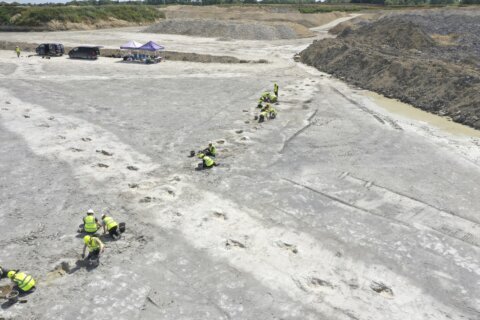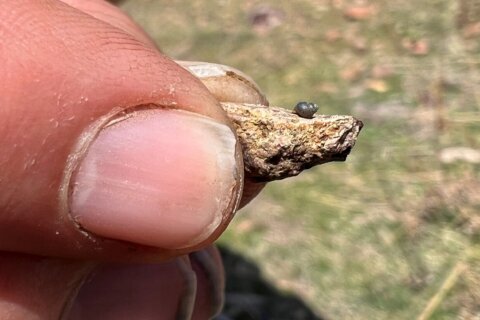SAN MATEO, Ecuador (AP) — Oswaldo Angulo is a born fisherman, like generations before him. The oldest of his brothers, he dropped out of high school in Ecuador to learn the trade with his father. When he isn’t at sea for weeks at a time, Oswaldo, 36, lives with his parents. He can’t imagine it any other way.
Marlon, the baby brother, also lived for the sea – he’s a natural navigator. But he fell into the drug trade, as many Ecuadorian fishermen had before him. The U.S. Coast Guard stopped Marlon’s speedboat, carrying 1 ton of cocaine, in 2018. Now 30, he’s serving an 11-year sentence.
Anthony, 32, the middle son, wasn’t drawn to the sea the way his brothers were. Instead, he earned a college degree in communications. But like many in this once-peaceful South American country, he was rattled bythe violence that hit like a hurricane over the past five-plus years. On Dec. 27, 2023, he fled his hometown of San Mateo for the U.S.
In this fishing village on the coast of Ecuador, the Angulo family personifies some of the forces driving migration to the U.S. Gangs have unleashed a wave of violence and extortion in every corner of this nation of 18 million people, upending lives and spurring an unprecedented exodus. Entire communities and industries have been consumed by it, and families torn apart. Many say they’ve been forced to flee to escape the lawlessness.
The threat of organized crime generally doesn’t qualify people for asylum in the U.S., but that hasn’t prevented Ecuadorians from leaving, making them the fourth-largest nationality arrested at the U.S. border with Mexico over the last year.
Those who flee often spend thousands of dollars and risk being killed or kidnapped. If they make it to the U.S., the world’s top destination for asylum-seekers since 2017, they enter into a system of overwhelmed immigration courts where cases can take years. Most people can stay and get work permits until they’re resolved.
In Ecuador’s tailspin of violence, there’s been diminished investment, lower wages and fewer jobs. Residents despair — some believe governments are ineffective or complicit, and they lose hope for a secure financial future and safe environment to raise children.
The feeling of desperation is far from unique to Ecuador. It drives migration in many other countries, including Mexico, Colombia, Honduras and Haiti.
At first, Anthony Angulo’s mother didn’t take his plans to leave for the U.S. seriously. But he’d seen too much change in Ecuador, for the worse.
“Extortion, kidnappings, death threats. So many things,” he said. “Years ago, everything was good there.”
He was particularly shaken when six fishermen from San Mateo disappeared, weeks before he left. He told his mother he’d been getting threatening text messages demanding money.
“Now is my opportunity,” he told her.
She didn’t try to dissuade him.
No part of Ecuador is unscathed
In San Mateo, everyone seems to know one another – the population is just 5,000, and many families have lived here for generations. On the hillsides, colorful houses have ocean views, and idled fishing boats outnumber cars on some of the winding streets.
The men fish for dozens of species, including tuna, marlin, shark, lobster, wahoo and dorado. They alternate between days or weeks at sea and preparations for the next trip. For some, like Oswaldo Angulo, it’s still a viable way to make a living. For others, opportunity has dried up alongside the violence.
Ecuador’s long Pacific coast boasts whale watching, scuba diving, a national park and its signature seafood dishes, but high-end hotels, luxury homes and fancy restaurants are few and far between. Just 8 miles (13 kilometers) from San Mateo is Manta, Ecuador’s main seafood port city. But the main coastal road to San Mateo is so blanketed with potholes that residents take collections from motorists to fill them with dirt. Homes are lit by candles when drought-induced nationwide blackouts come at night, a result of Ecuador’s heavy dependence on hydropower.
Other signs of unfilled economic promise dot the landscape of San Mateo and nearby areas. Remnants of a government oil refinery project look like nothing more than a heap of junk, since construction was halted after spending $1.5 billion. A deforested horizon of never-used aqueducts remains, with freshly paved but rarely traveled roads.
Ecuador at large was long a peaceful spot for the region, a world away from the warfare of some other nations. But drug trafficking, gang fights for control, and waves of violence rocked the country, starting around 2018.
President Daniel Noboa, a 36-year-old heir to a banana fortune up for reelection next year, deployed the army to fight gangs but faces an enormous adversary in Ecuadorian gangs backed by powerful Mexican and Albanian cartels.
Hardest hit has been the area of Guayaquil, Ecuador’s biggest city and home to a bustling port. No part of the country has been unscathed – Ecuador is home to five of the 10 cities with the world’s highest murder rates, with Manta at No. 3. Last year, the Manta mayor, a mayoral candidate in the nearby fishing village of Puerto Lopez, and a leading presidential candidate were assassinated.
Gang members and associates go door to door, demanding “vacunas” – monthly payments in exchange for protection. Sometimes these extortion demands come from neighbors, acquaintances. The demands show up as texts on mobile phones, or threats of violence for refusal to pay.
The vacunas – literally, vaccine in English — affect Ecuadorians of all classes and income levels, choke the economy, and sow fear.
In Guayaquil, stores might pay about $2,000 monthly to stay in business, while street food stands $50 or 100, residents say. Taxi drivers pay to drive in certain neighborhoods. Those who refuse might be killed, kidnapped or robbed.
In San Mateo and other fishing villages, vacunas for boat owners are $140 monthly per motor, or $280 for the twin-motor vessels needed for longer voyages. Fishermen say they get plastic tags that look like debit cards and read “Choneros 100%” — named for the gang that controls the area.
Vacunas are supposed to prevent theft at sea, but some who pay are robbed anyway.
For some fishermen, vacunas are too much to pay. For others, the extortion payments cut into profits for any business, translating to lower wages and fewer job opportunities.
Deaths and disappearances hit home in San Mateo
By December 2023, violence and extortion had become a part of everyday life for the Angulos and the rest of San Mateo. But the disappearance that month of the six local fishermen, including two teenagers, traumatized them.
Alarm spread as days went by with no word from the crew. The military found nothing, so townspeople banded together for an exhaustive search. The city of Manta supplied them with fuel.
That search eventually turned up three bullet-ridden bodies. The others haven’t been found and are presumed dead.
Valentina Lucas, who lives two blocks from the Angulo family, lost her 36-year-old husband and a 16-year-old nephew. The couple had two boys, one 12 and the other 3, whose only words are “mama” and “papa.”
“He always left in the middle of the night and, before going, he held me tight, gave me a hug and a kiss, and said take care of the children,” Lucas, 28, said of her husband.
There have been no arrests, and any motives are unclear. Witnesses say radios were stolen, but the boat’s older motor was left.
It was the last straw for Anthony Angulo. Gangs had been after him for extortion money. He’d had enough.
The family sold a boat motor that father and family patriarch Alfonso, now 62 and blind from diabetes, had remaining after retiring from 45 years in the business. Anthony paid $1,300 to fly to El Salvador and had $2,000 wired to him for smugglers to get him to the U.S. border.
Officials say they’re outmatched
Even local authorities say they understand why Anthony and others leave.
Javier Briones, who oversees public safety for the Manta-area government, including San Mateo, said police simply find themselves outmatched by the gangs and criminals. Police have lacked money for even batteries for their radios, he said.
“The police try to drive 100 kilometers an hour, the tires and doors are barely holding together,” he said. “Organized crime groups are driving 150 and flying.”
When the San Mateo fishermen went missing, Briones said, he boarded a military ship to search for them. He gave residents gas for their own searches.
When the corpses were found, hundreds somberly packed the small beach.
Given these deaths, other crime and economic hardships, Briones said he understands the exodus – especially of fishermen and their families.
A stolen motor costs $12,000 to $20,000 to replace. Officials say about 200 have been stolen at sea from townspeople since 2018, a sharp increase from previous years.
And, Briones noted, fishermen profit less and pay crews less when extorted.
“People have gone broke and don’t see how to recover from losing motors that were their livelihood,” he said. “People have lost their boats, people have lost all that and are very damaged, suffering psychologically and treated very badly.
“We do what we can with what we have.”
Oswaldo Angulo notices many fishermen leaving for the U.S. He works on large industrial ships — unlike the small ones many of his relatives and neighbors use, paying vacunas to operate them on their own — and is relatively unfazed by the violence. But his crews have limited their departures for monthlong trips to early evening hours, considered the best time to avoid the growing presence of bandits who look for victims close to shore.
The route to the U.S. is treacherous and expensive
Anthony Angulo is part of Ecuador’s largest wave of migration in recent history, surpassing two considerable ones in the early 2000s to the U.S. and Europe sparked by economic crisis. Then, the area around San Mateo was the epicenter, with fishermen packing migrants on boats to Guatemala and Mexico.
Since January 2021, the U.S. Border Patrol has arrested Ecuadorians about 350,000 times. During that time, Panama registered more than 100,000 Ecuadorians walking through the Darien Gap, a rugged 60-mile (96-kilometer) stretch of jungle, laden with snakes, scorpions and other dangers.
Migrants who pass through the Darien are often among the poorest – it might cost a few hundred dollars in transportation and other expenses.
Others buy round-trip airfare to El Salvador and pay $90 for a passport to skip the jungle. Smugglers charge several thousand dollars to reach the U.S. from El Salvador.
Anthony Angulo was among the latter group.
He made it to the U.S. after crossing the Rio Grande in Brownsville, Texas. He surrendered to border agents and spent three months in Georgia and Mississippi jails. He was released with a court date to pursue asylum – in December 2027.
Anthony lives with a friend in Bayonne, New Jersey, while working at a factory that makes snack products. He sends money from paychecks back home.
His mother Maribel Montenegro, 54, sends him food from San Mateo for a taste of home.
She takes comfort that Anthony is near his younger brother. Marlon is imprisoned in neighboring Pennsylvania, scheduled for early release in December 2026, and will likely be deported. Anthony hasn’t seen him in years and said he looks forward to visiting him there for the first time.
For Anthony, jail was a time of reflection. Maybe, he realized, he didn’t fully appreciate his life in Ecuador. He said he’d like to go back when it’s safer.
But when will that be? No one in his family or San Mateo can say.
“I can’t return to Ecuador until things get better,” he said.
___
This story was supported by funding from the Walton Family Foundation. The AP is solely responsible for all content.
Copyright © 2025 The Associated Press. All rights reserved. This material may not be published, broadcast, written or redistributed.







